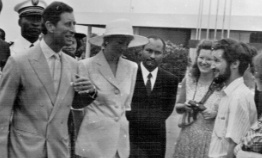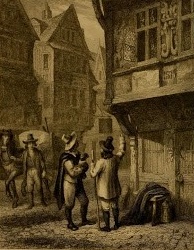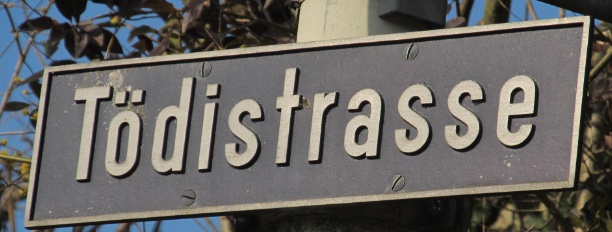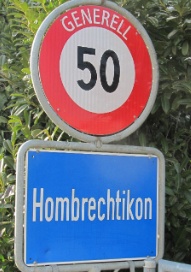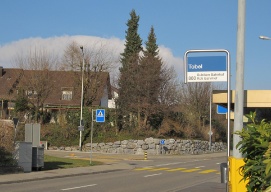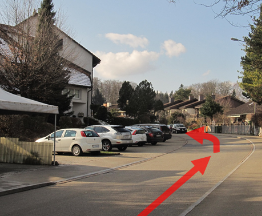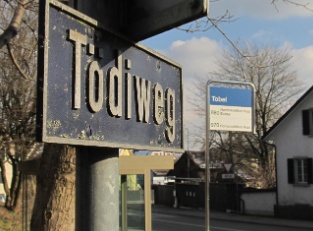June 2017
Monday, 12th June 2017
I wouldn’t describe myself as a cyclist. You won’t see me pedalling around Lake Zurich at the weekend wearing sporty clothes and a stream-lined helmet.
But I am a convinced cycle user. Whenever I can, I use my bicycle as a practical means of getting from A to B.
As a result I was interested to hear on the radio today that they were celebrating the bicycle’s bi-centenary.
But I am a convinced cycle user. Whenever I can, I use my bicycle as a practical means of getting from A to B.
As a result I was interested to hear on the radio today that they were celebrating the bicycle’s bi-centenary.
Two hundred years of the bicycle
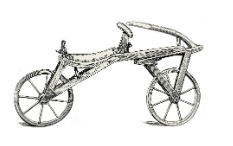
On this day in 1817 a German nobleman and inventor, Baron Karl von Drais, first demonstrated in public his Laufmaschine. It was a simple, not very elegant, machine with a heavy wooden frame.
It did have several of the things which a bicycle needs to have, a frame with a seat on it and underneath the frame, two wheels arranged in a straight line. An important feature of Karl von Drais’s invention was that the rider was able to steer the front wheel by means of a horizontal bar.
On the other hand it didn’t have several of the features which belong to the modern bike. Most notably, it didn’t have a drive system: no pedals and no chain. The rider pushed the vehicle along with his feet. That doesn’t sound very efficient, but it is reported that on his maiden voyage in Mannheim in June 1817, von Drais covered an impressive 13 kilometres in one hour.
Another thing that the invention did not have was the name bicycle. It was first known by the name Draisine and soon after that it was given its more familiar name velocipede, which still survives today in the French and Swiss-German name vélo / Velo.
It did have several of the things which a bicycle needs to have, a frame with a seat on it and underneath the frame, two wheels arranged in a straight line. An important feature of Karl von Drais’s invention was that the rider was able to steer the front wheel by means of a horizontal bar.
On the other hand it didn’t have several of the features which belong to the modern bike. Most notably, it didn’t have a drive system: no pedals and no chain. The rider pushed the vehicle along with his feet. That doesn’t sound very efficient, but it is reported that on his maiden voyage in Mannheim in June 1817, von Drais covered an impressive 13 kilometres in one hour.
Another thing that the invention did not have was the name bicycle. It was first known by the name Draisine and soon after that it was given its more familiar name velocipede, which still survives today in the French and Swiss-German name vélo / Velo.
Why?
One interesting question is why Karl von Drais invented his Draisine at all.
One suggestion has to do with climate change. 1816, the year before von Drais demonstrated his machine, is known as the “year with no summer”.
We now know that the appalling harvests that year were cause by a volcano in South East Asia which had violently erupted the previous year (1815). Ash from the eruption had blocked out the sun and has lowered temperatures all over the world. Harvests that year were disastrous. Many people starved, and so did many animals. By 1817 there was a shortage of horses, and maybe that was what prompted von Drais to build his primitive bicycle.
Very soon rich young men in Europe’s cities took to riding around on hobby-horses, as the velocipedes were called in England.
One suggestion has to do with climate change. 1816, the year before von Drais demonstrated his machine, is known as the “year with no summer”.
We now know that the appalling harvests that year were cause by a volcano in South East Asia which had violently erupted the previous year (1815). Ash from the eruption had blocked out the sun and has lowered temperatures all over the world. Harvests that year were disastrous. Many people starved, and so did many animals. By 1817 there was a shortage of horses, and maybe that was what prompted von Drais to build his primitive bicycle.
Very soon rich young men in Europe’s cities took to riding around on hobby-horses, as the velocipedes were called in England.
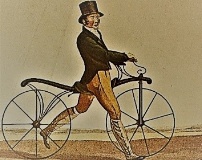
Whether or not that is true, the newly invented hobby-horse became extremely popular and by 1818 an improved version with a more elegant curved frame, could be seen all over London.
It was not until the 1860s that inventors in France added cranks and pedals to the basic velocipede and created something which is similar to the bicycle we know today.
Well, back to the present, to 12th June 2017. Swiss radio marked the two-hundredth anniversary with a series of broadcasts, and as part of that they asked listeners to send in their own personal “bike story”. It so happens that I have got a bike story. I didn’t send it in to the radio, but here it is for you to read.
It was not until the 1860s that inventors in France added cranks and pedals to the basic velocipede and created something which is similar to the bicycle we know today.
Well, back to the present, to 12th June 2017. Swiss radio marked the two-hundredth anniversary with a series of broadcasts, and as part of that they asked listeners to send in their own personal “bike story”. It so happens that I have got a bike story. I didn’t send it in to the radio, but here it is for you to read.
My old hobby-horse
In 2007 I had to return unexpectedly to England to be with my mother who was in hospital. For several months I lived in the house near Bristol where I had grown up. In the shed behind the house stood my old bicycle. The bicycle dated back to the nineteen-seventies and had originally belonged to my elder brother. Over the years I had made several changes to the bike. For example, in the eighties I had sprayed it with gold paint, but the paint job wasn’t very successful and the colour looked patchy and uneven. I had also removed the broken front gear-changer, so that it only had five gears instead of the original ten. I had replaced the mud-flaps with home-made ones, and all the cables were held in place with PVC tape. In general the bike had a slightly one-sided, crooked, appearance, although I’m not sure why. This was the bike that had taken me on long tours over mountain passes in Wales, the Yorkshire Dales and the Lake District. But above all it had been my usual means of getting around locally.
I took the bicycle out of the shed and cleaned it up and oiled it. I have to admit that it didn’t look very good. However, when I tried it out, I was amazed: it ran perfectly. In fact, it fitted me so exactly that it travelled more swiftly and smoothly than many more modern bicycles on the road. In short, I decided to keep it. For a few days I faithfully rode it back and forth to the hospital to visit my mother.
But then one weekend something happened which changed my mind. I was riding along a cycle path in my home village of Stoke Gifford when I came upon a father and his three-year old daughter. The little girl was chatting away non-stop, as three-year-olds often do. But when I appeared on the scene on my scruffy old bike the little girl stopped in mid-sentence and watched me in disbelief, her mouth wide open. When she managed to speak again, the only word that she could say was, “Yuck!”
I took the bicycle out of the shed and cleaned it up and oiled it. I have to admit that it didn’t look very good. However, when I tried it out, I was amazed: it ran perfectly. In fact, it fitted me so exactly that it travelled more swiftly and smoothly than many more modern bicycles on the road. In short, I decided to keep it. For a few days I faithfully rode it back and forth to the hospital to visit my mother.
But then one weekend something happened which changed my mind. I was riding along a cycle path in my home village of Stoke Gifford when I came upon a father and his three-year old daughter. The little girl was chatting away non-stop, as three-year-olds often do. But when I appeared on the scene on my scruffy old bike the little girl stopped in mid-sentence and watched me in disbelief, her mouth wide open. When she managed to speak again, the only word that she could say was, “Yuck!”

From that moment on I realised that my faithful old bicycle was no longer cool, just embarrassingly shabby. A few days later I took it to our local recycling centre (pun intended) and reluctantly threw the machine into the scrap metal skip.
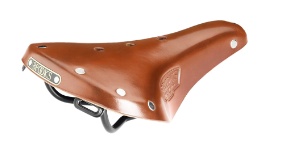
But there was one part of the bike that I didn’t throw into the skip: the saddle. The bike had had an old Brooks leather saddle. I had always found the saddle very comfortable.
Like the rest of the bike it had got quite shabby. But the great thing was that it didn’t matter! Recently these saddles have become very fashionable – shabby chic in fact. You can even buy new leather saddles which have been treated to make them look old and used. So, I didn’t throw the saddle away, but I mounted it on my new bike, where it serves as a souvenir of my old hobby-horse.
Like the rest of the bike it had got quite shabby. But the great thing was that it didn’t matter! Recently these saddles have become very fashionable – shabby chic in fact. You can even buy new leather saddles which have been treated to make them look old and used. So, I didn’t throw the saddle away, but I mounted it on my new bike, where it serves as a souvenir of my old hobby-horse.
Front page story
Look back to 1665: the Plague Year
Contact
If you’re interested in English lessons or translation and checking services, please feel free to contact me in the language of your choice - English, French, German or even Lingala!
Here are my details:
Here are my details:
Mobile
078 609 56 51
+41 78 609 56 51
+41 78 609 56 51
Location
Tödistrasse 9, 8634 Hombrechtikon
(New address from 24th March 2018)
(New address from 24th March 2018)
If you are travelling from Rüti / Wolfhausen, drive past the Hombrechtikon place-name sign for about 300 metres and turn right into Tödistrasse, just before the Tobel bus stop.
Approaching from Hombrechtikon
If you are approaching from the centre of Hombrechtikon, follow the signs to Rüti. At the Tobel junction (the Methodist Church is on the left) turn left. Tödistrasse is the next turning on the left, just past the Tobel bus stop.
The entrance to our new flat is about 100 metres from the junction with Rütistrasse, on the left-hand side of the road.
The house number is number 9 and we are on the first floor.
There are a few visitor’s parking bays a short distance beyond the entrance, on the left.
There are a few visitor’s parking bays a short distance beyond the entrance, on the left.
Arriving by bus
If you arrive by bus from Bubikon, get off the bus at Tobel and follow Tödiweg until you get to Tödistrasse. Our house is on the right.


